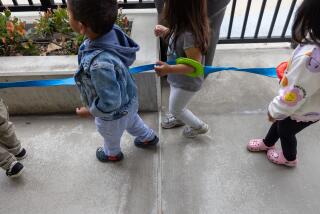Reaching L.A.’s ‘unbanked’
Being poor is hard enough. Having to squander what little money you have on payday lenders, check cashers and other high-cost financial services only makes matters worse. For too many Angelenos, when it comes to managing money, that’s all they know and sometimes all they have access to. Life without banks, and the knowledge to use them, is costing them and the rest of us too much.
High-cost financial services for the poor are a problem all over the United States, but Los Angeles is especially hard hit. A 2006 Scarborough Research study found that we have the nation’s largest “unbanked” population.
In Southeast Los Angeles, according to a 2008 Brookings Institution report, the number of check cashers, pawnshops and payday lenders is five times larger than the number of banks and credit unions.
Based on Pew Research Center estimates, if the poor could avoid using these establishments, they would save nearly $150 million a year in fees. That’s about four times the federal job-training funds spent in Los Angeles.
If the city is hoping for an anti-poverty strategy suited for tight finances and tough times, getting more people to use banks may just be the way to go.
So what’s stopping demand from meeting supply? After all, if the bottom-feeders in the financial industry are able to profit from low-income consumers, why not the banks, which can offer better services -- checking accounts rather than expensive check cashing; the opportunity to build credit and get access to regular loans -- at lower prices?
For starters, banks may not realize the nature of the potential market. The media, not to mention social scientists and demographers, are proficient in highlighting needs (that is, weaknesses) in the inner city, rather than emphasizing how population densities and relatively high rates of employment could mean hospitable territory for banks.
In nine of L.A.’s low-income neighborhoods studied by Social Compact, a Washington-based nonprofit research organization, the number of people and households was about 10% to 20% higher than that recorded by the U.S. census, and total income also was significantly higher. According to a 2006 Brookings study, more than two-thirds of those without a checking account in L.A. work steadily.
But the problem is not only a matter of the banks’ failure to see the market. Those on both sides of the teller’s counter need to do more to make banks work in these neighborhoods.
Banks may offer low-cost checking accounts, but information about the accounts is often poorly publicized. Branches, which may be expected to turn a profit in three to four years, also may react to small deposits, thin credit histories and occasional overdrafts with such high interest rates or exorbitant fees that they drive away consumers before they can master the shift from payday lenders to formal banking.
The consumer needs to be educated about what the bank expects as well. In general, the lower the consumer’s income, the less likely he or she is to have a solid knowledge of how checking and savings accounts work. This “soft” barrier is exacerbated because the poor are concentrated in underserved areas and are thus less likely to have neighbors or family members who have banking experience.
The racial dimension is striking: According to the Center for Financial Services Innovation, whites are 24% of the residents of low- and moderate-income areas in Los Angeles, but they make up less than 2% of the population that doesn’t use a bank; Latinos account for 75% and African Americans 21% of that population.
Emerging Markets, a nonprofit in central L.A., has shown what’s needed for banks and low-income consumers to come together effectively. Using what it calls “neighborhood delivery systems” -- existing community organizations and networks -- it worked with Wells Fargo & Co. as that bank opened a branch in heavily immigrant Pacoima. The effort to get the word out and to match banking with qualified customers succeeded.
Can those results be replicated? The city of Los Angeles has begun a “Bank on L.A.” project that could help. In Westlake, Boyle Heights, Vernon Central and Pacoima, the program seeks to do much the same thing as the Emerging Markets project on a larger scale: bringing appropriate bank services to qualified consumers and vice versa, and helping community organizations teach “financial literacy.” The specific goal is 10,000 new bank accounts a year in these neighborhoods. The project also will measure the results of getting poor people out of check-cashing businesses and into banks.
But that is only a beginning. The city must take the lead in viewing inner-city neighborhoods as untapped markets rather than as charity cases. Bankers have to take a chance -- with profits as the lure -- on new markets. And community organizations have to help by educating consumers.
It might seem an inopportune time to steer banks in the direction of social justice. But making the financial system fairer could be part of the stimulus the economy needs.
More to Read
Inside the business of entertainment
The Wide Shot brings you news, analysis and insights on everything from streaming wars to production — and what it all means for the future.
You may occasionally receive promotional content from the Los Angeles Times.










